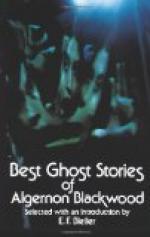If there be any who has not, it may be that to him ghost stories have no fascination. Let him at least, however, be honest.
To every human being mystery appeals, be it that of the crime cases on which a large part of yellow journalism is founded, or be it in the cases of Dupin, of Le Coq, of Sherlock Holmes, of Arsene Lupin, of Craig Kennedy, or a host of others of our fiction mystery characters. The appeal is in the mystery.
The detective’s case is solved at the end, however. But even at the end of a ghost story, the underlying mystery remains. In the ghost story, we have the very quintessence of mystery.
Authors, publishers, editors, dramatists, writers of motion pictures tell us that never before has there been such an intense and wide interest in mystery stories as there is to-day. That in itself explains the interest in the super-mystery story of the ghost and ghostly doings.
Another element of mystery lies in such stories. Deeper and further back, is the supreme mystery of life—after death—what?
“Impossible,” scorns the non-psychic as he listens to some ghost story.
To which, doggedly replies the mind of the opposite type, “Not so. I believe because it is impossible.”
The uncanny, the unhealthy—as in the master of such writing, Poe—fascinates. Whether we will or no, the imp of the perverse lures us on.
That is why we read with enthralled interest these excursions into the eerie unknown, perhaps reading on till the mystic hour of midnight increases the creepy pleasure.
One might write a volume of analysis and appreciation of this aptly balanced anthology of ghost stories assembled here after years of reading and study by Mr. J.L. French.
Foremost among the impressions that a casual reader will derive is the interesting fact, just as in detective mystery stories, so in ghost stories, styles change. Each age, each period has the ghost story peculiar to itself. To-day, there is a new style of ghost story gradually evolving.
Once stories were of fairies, fays, trolls, the “little people,” of poltergiest and loup garou. Through various ages we have progressed to the ghost story of the eighteenth and nineteenth centuries until to-day, in the twentieth, we are seeing a modern style, which the new science is modifying materially.
High among the stories in this volume, one must recognize the masterful art of Algernon Blackwood’s “The Woman’s Ghost Story.”
“I was interested in psychic things,” says the woman as she starts to tell her story simply, with a sweep toward the climax that has the ring of the truth of fiction. Here perhaps we have the modern style of ghost story at its best.
Times change as well as styles. “The Man Who Went Too Far” is of intense interest as an attempt to bring into our own times an interpretation of the symbolism underlying Greek mythology, applied to England of some years ago.




